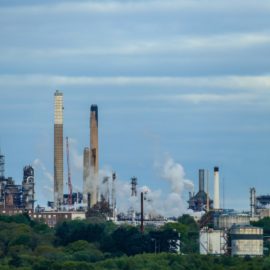
Ethylene oxide. A common chemical in Louisiana and one the EPA is taking another look at. Residents say there is too much of it and industry says the amounts have lowered. Hopefully this will determine who is right and might come with more regulations on the chemical industry.
The U.S. Environmental Protection Agency was six years overdue when it issued new Clean Air Act rules in 2020 to strengthen protection for communities against air pollution from chemical plants. But after urging from the industry, the agency has now agreed to reconsider how it assessed the cancer risk posed by one toxic air pollutant common in Louisiana: ethylene oxide. Deemed a likely human carcinogen by the EPA, ethylene oxide is produced while manufacturing ethylene glycol, a raw material used to make a number of products such as antifreeze and polyester fibers for plastic. As of 2018, 13 of the 15 Louisiana plants that fall under EPA’s rule release enough ethylene oxide that they must report it to the agency’s Toxics Release Inventory public database. The American Chemical Council, an advocacy group, argues that the EPA overestimated ethylene oxide’s cancer risk when issuing the new rules. The council points to a Texas Commission for Environmental Quality assessment that suggests the EPA erred in evaluating the chemical. Using a different predictive model, the Texas agency found the cancer risk to “be 4,000 times lower” than EPA found, the American Chemistry Council said. The Texas agency and the chemistry council pushed EPA to use the Texas study, and the federal agency agreed June 17 to reevaluate its rule. Should the EPA revise the rule, it could led to less regulation on the industry.
nola.com

Emissions of ethylene oxide from major chemical plants in Louisiana
Environmentalists have questioned the Texas study as it did not look at the chemical causing breast cancer instead focusing on lymphoid cancer. Texas says there was insufficient data to make that decision.
Jennifer Jinot, a former EPA scientist who contributed to the agency’s 2016 cancer assessment of ethylene oxide, said the Texas study’s findings “dramatically underestimate” potential cancer risks due to its exclusion of breast cancer and the type of model used to estimate lymphoid cancer risk – a model that the EPA had rejected during its own assessment. The Texas agency is also tied up in a legal battle with the Sierra Club over its refusal to release the documents that it relied on to determine risk value.
The new study will validate the Texas study or not as one of its byproducts. There is no known time line for the study.
Eleven environmental groups from across the country – including RISE St. James, the Louisiana Environmental Network and the Louisiana Bucket Brigade – have also petitioned the EPA for changes to its rule. They say the rule doesn’t go far enough to protect people living near plants from the health risks associated with the emissions, and they call for measures such as requiring fenceline monitoring and removing loopholes for pollutants released during equipment malfunctions. The EPA has not decided whether to accede to their requests. Earthjustice senior attorney Emma Cheuse said this will be one of the first tests for President Joe Biden’s EPA. Biden made campaign promises to strengthen environmental justice protections for communities facing air pollution, specifically offering his support to those living in Louisiana’s heavily industrialized chemical corridor along the Mississippi River between New Orleans and Baton Rouge. “Five months into the new administration, we are still waiting to see whether EPA will take strong, definitive action to protect fenceline communities and public health from chemical and petrochemical plants’ pollution,” Cheuse said. “EPA’s review should be completed quickly and should end with affirmation of EPA’s … cancer risk value as the best available science, and with stronger rules based on this science.”
The battle continues and with the changed administration hope is up that the EPA will come through for the residents.



